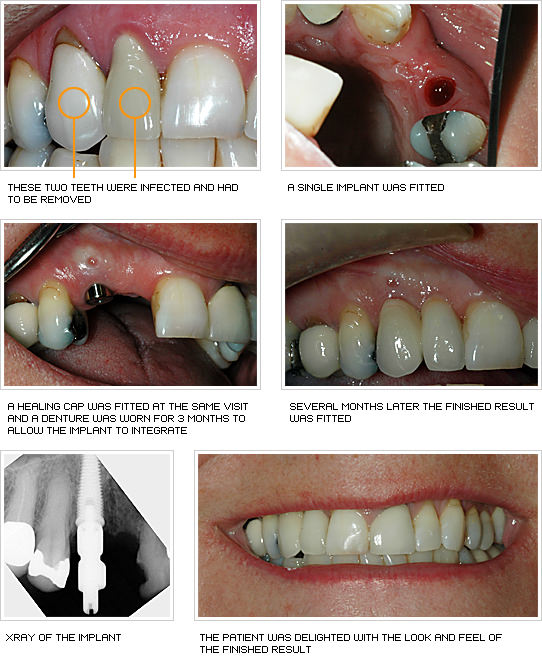Getting The Dental Sense To Work
Getting The Dental Sense To Work
Blog Article
The 7-Second Trick For Dental Sense
Table of ContentsMore About Dental SenseThe Main Principles Of Dental Sense Dental Sense - QuestionsThe Facts About Dental Sense Uncovered
are medical gadgets surgically implanted right into the jaw to recover an individual's capability to eat or their appearance. They supply support for man-made (fake) teeth, such as crowns, bridges, or dentures. When a tooth is lost because of injury or condition, a person can experience difficulties such as rapid bone loss, malfunctioning speech, or modifications to eating patterns that lead to pain.Oral implant systems include an oral implant body and dental implant joint and might also include a joint addiction screw. Cosmetic dentistry services. The oral implant body is operatively placed in the jawbone in place of the tooth's root. The dental implant joint is generally connected to the implant body by the joint fixation screw and extends with periodontals into the mouth to sustain the attached man-made teeth
(https://linktr.ee/dentalsense1)Framework of The Dental Implant System picking oral implants, talk to your oral supplier concerning the potential advantages and risks, and whether you are a prospect for the treatment. Points to consider: Your overall health and wellness is a vital element in identifying whether you are an excellent prospect for dental implants, the length of time it will take to recover, and for how long the implant might remain in location.
Smoking cigarettes may affect the healing procedure and decrease the long-lasting success of the implant. The recovery procedure for the implant body may take a number of months or longer, throughout which time you normally have a short-lived joint instead of the tooth. the dental implant treatment: Thoroughly comply with the oral health guidelines provided to you by your dental company.
Excitement About Dental Sense
Implant failing can cause the need for another procedure to deal with or replace the dental implant system. Recovers the capability to eat Restores cosmetic look Aids keep the jawbone from reducing as a result of bone loss Maintains the wellness of the bordering bone and gum tissues Assists maintain nearby (close-by) teeth secure Improves high quality of life Damages to bordering all-natural teeth during dental implant placement Injury to the surrounding tissues during surgery, such as sinus perforation Injury during surgery (for instance, crack of bordering jawbone) Insufficient function, such as feeling like the teeth do not bite with each other generally A sensation that the tooth is loose or turning in position resulting from a joint screw loosening Implant body failing (looseness of the implant body) as a result of systemic infection, which may be most likely in clients with unrestrained diabetes mellitus because of regional infection in bone and gums supporting the dental implant body due to postponed recovery, which may be most likely in clients who smoke Trouble cleaning the periodontals around the implant, causing bad dental health Unattended periodontal illness Post-surgical feeling numb as a result of nerve impingement or damages Always notify healthcare providers and imaging technicians that you have dental implants before any type of magnetic vibration imaging (MRI) or x-ray procedures.
FDA is not familiar with any damaging events reported for MRI or x-ray procedures with dental implants. Oral implants systems are generally made from materials that adhere to worldwide consensus criteria of the International Organization for Standardization (ISO) or ASTM International. These standards have information of what makes a safe product.

An oral implant is a framework that replaces a missing tooth. With screw-like tools, the surgeon inserts a dental implant right into the jawbone, and it serves as a support for a man-made tooth, called a crown. A tool called a joint links the artificial tooth to the oral implant. The crown is tailor-made to fit the person's mouth and match the shade of their teeth.
The 6-Minute Rule for Dental Sense
Some people are not eligible for oral implant surgery. It is for oral surgeons to operate individuals with: intense illnessuncontrollable metabolic diseasebone or soft cells condition or infectionIf these issues are dealt with, an individual can have the surgery. In, dental cosmetic surgeons avoid operating individuals with: If individuals with any of the above undergo oral implant surgical procedure, there is a greater danger of the dental implant stopping working.

Dental dental implant surgical treatment is a personalized procedure. Give you time to recover. Attach the message and last crown, bridge or denture.
Next, your doctor will very carefully place the dental implant into your jaw. If your implant is near the front of your mouth, your dental practitioner will make a temporary tooth for you to wear till you heal.
Getting The Dental Sense To Work
Throughout the recovery phase, your jawbone should fuse to the oral implant. This process can take anywhere from 3 to 9 months.
When your implant heals, your dentist can connect the joint (tiny adapter post) and your last reconstruction (crown, bridge or denture). This usually takes regarding one hour to finish and might require a second minor surgery. You should not feel any pain during your oral implant treatment since your provider will use Learn More Here drug to numb your periodontals.
Report this page